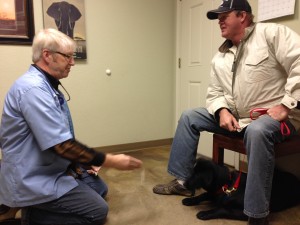 When is the best time to give a pet pain medication? Before the pain starts, or as soon after as possible.
When is the best time to give a pet pain medication? Before the pain starts, or as soon after as possible.
While human beings might like being “tough guys” who never take anything for pain, there’s no benefit, and plenty of harm, in letting your dog or cat suffer. (There’s none in letting yourself suffer, either, but I’ll let the MDs handle that conversation!)
That’s because of a phenomenon known as “wind-up,” or the sensitization of nerve pathways to pain, making things that hurt feel more painful the longer the pain persists. Preventing or interrupting wind-up not only makes your pet feel better, it prevents the development of chronic or disabling pain syndromes that might require weeks, months, or a lifetime of pain control to prevent suffering.
From “Managing Difficult Pain Cases: Neuropathic Pain and Wind-Up Phenomenon” by Nancy Shaffran CVT, VTS (ECC) (paragraph breaks for improved readability mine):
The central nervous system adapts adversely to repetitive pain impulses after prolonged stimulation of nociceptors. This can cause a profound effect the nervous system’s architecture thereby altering pain processing.
When spinal neurons are subjected to repeat or high-intensity nociceptive impulses, they become progressively and increasingly excitable even after the stimulus is removed. This condition is known as central sensitization or wind-up phenomenon and leads to nonresponsive or chronic intractable pain.
Wind-up is the culmination of two distinct phases of change in the nervous system. First, pain transmitting nerve fiber threshold is reset. This resetting results in hyperalgesia where less and less stimulation is required to initiate pain.
In the second phase, nerve fibers that normally carry non painful information are recruited and become part of the pain transmission process. This phase is termed allodynia and results in normally harmless sensations being interpreted as pain. The presence of hyperalgesia and allodynia collectively is considered wind-up phenomenon.
This is apparent, for example, in the dachshund with disk disease that cries out in pain when any part of its body is touched, or the cocker spaniel with a chronic ear infection that can no longer tolerate normal petting. This phenomenon highlights the need for preemptive analgesia to treat pain before it begins and at regular intervals post-operatively.
What can you do so your veterinarian can treat and prevent wind-up in your pet?
1. If your pet is already in pain, or has a planned surgery, share this article from the American Animal Hospital Association website with your veterinarian with a request that you discuss options.
2. Ask for a referral to, or that your vet consult with, a pain specialist at a veterinary teaching college.
3. Take your pet’s pain seriously.
The idea that a little pain is a good way to restrain a pet during recovery from injury or surgery is outdated and unkind. Modern science tells us that there’s no gain from pain, only suffering and possibility of permanent harm.

